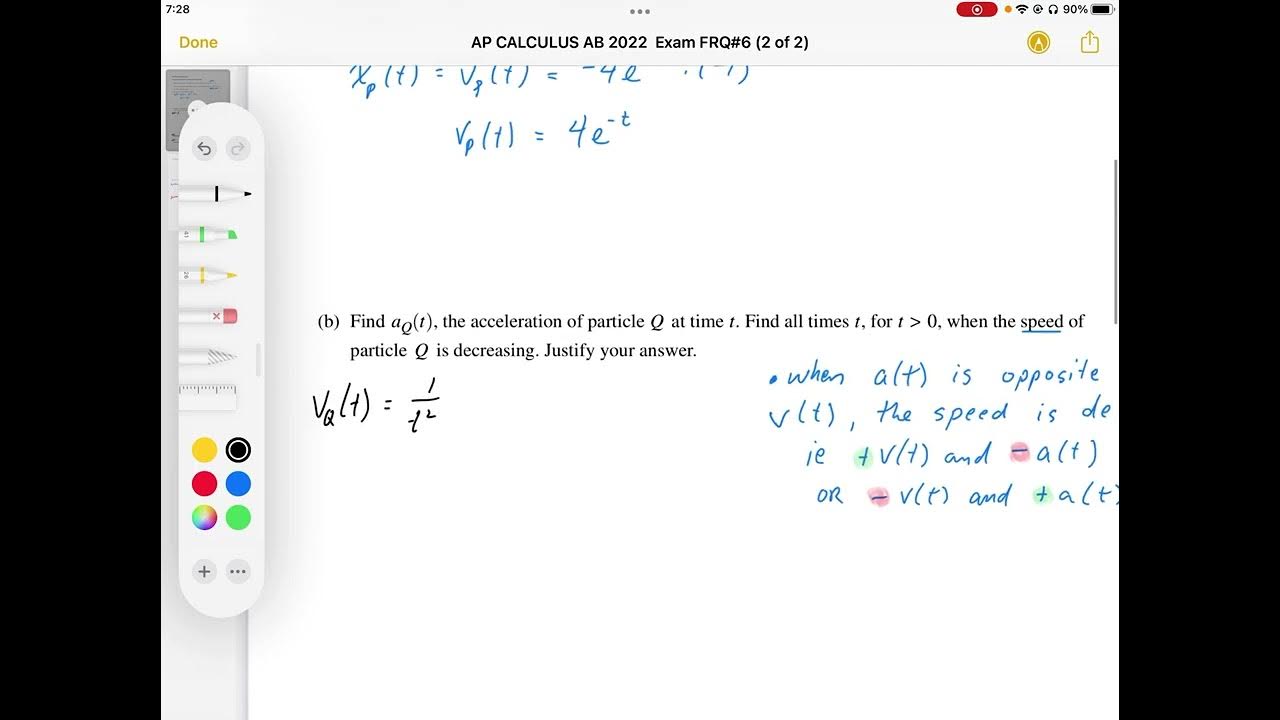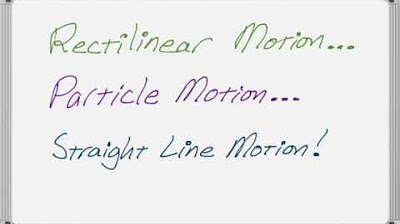Worked example: Motion problems with derivatives | AP Calculus AB | Khan Academy
TLDRThe video script discusses the concept of velocity and acceleration in the context of a particle moving along the x-axis. It explains that velocity is the derivative of position with respect to time, and acceleration is the derivative of velocity with respect to time. The script illustrates how to calculate the velocity and acceleration at specific time points, such as t=2 and t=3, using the given position function x(t). It also clarifies the difference between velocity and speed, noting that speed is the magnitude of velocity and does not include direction. The example shows that at t=2, the particle is moving to the left with a velocity of negative one, and at t=3, the particle's speed is increasing due to the positive acceleration and velocity being in the same direction.
Takeaways
- 📐 The velocity of a particle is the derivative of its position with respect to time.
- 🔢 To find the velocity at a specific time, substitute that time into the velocity function.
- 📉 A negative velocity indicates that the particle is moving to the left along the x-axis.
- 🔁 The acceleration is the derivative of the velocity, which is the second derivative of the position.
- ⏱ At time t equals two, the particle has a velocity of negative one, suggesting leftward motion.
- 🚀 At time t equals three, the acceleration is positive ten, indicating an increase in velocity.
- ➡ The direction of motion at t equals two is to the left, as the velocity is negative.
- 🔄 The speed of the particle at t equals three is increasing because both velocity and acceleration are positive.
- 📌 Speed is the magnitude of velocity and does not include direction, thus ignoring the velocity's sign.
- ↔ At t equals three, since the velocity and acceleration are in the same direction (both positive), the speed increases.
- ⚖ Remember that if velocity and acceleration have different signs, the speed decreases, as the magnitude of velocity would become less.
Q & A
What is the relationship between a particle's velocity and its position as a function of time?
-The velocity of a particle as a function of time is the derivative of its position with respect to time. This means that to find the velocity at any given time, you would take the derivative of the position function.
How do you find the velocity of a particle at a specific time, such as t=2?
-To find the velocity at a specific time, you substitute the value of that time into the velocity function, which is the derivative of the position function. In this case, you would substitute t=2 into the velocity function to get the velocity at that time.
What does the sign of the velocity indicate in terms of the particle's direction of motion?
-The sign of the velocity indicates the direction of the particle's motion along the x-axis. A positive velocity indicates the particle is moving to the right, while a negative velocity indicates the particle is moving to the left.
How is acceleration related to velocity and position?
-Acceleration is the derivative of velocity with respect to time, which is also the second derivative of the position function with respect to time. It describes the rate at which the velocity of the particle is changing.
What is the acceleration of the particle at t=3?
-To find the acceleration at t=3, you would substitute t=3 into the acceleration function, which is the derivative of the velocity function. In this case, the acceleration at t=3 is calculated to be 10.
What does the direction of the particle's motion at t=2 imply?
-At t=2, the velocity is negative, which implies that the particle is moving to the left along the x-axis. The direction of motion is determined by the sign of the velocity at that time.
How can you determine if the particle's speed is increasing, decreasing, or neither at t=2?
-To determine if the speed is increasing or decreasing, you look at the signs of both the velocity and acceleration at that time. If both are positive or both are negative, the speed is increasing. If the signs are different, the speed is decreasing. At t=2, the velocity is negative, but without knowing the acceleration at that time, we cannot definitively say if the speed is increasing or decreasing.
What is the difference between velocity and speed?
-Velocity is a vector quantity that includes both the magnitude and direction of an object's motion, while speed is a scalar quantity that only refers to the magnitude of the velocity, without regard to its direction.
At t=3, is the particle's speed increasing, decreasing, or neither?
-At t=3, the particle's speed is increasing. This is because both the velocity and acceleration are positive, indicating that the magnitude of the velocity is increasing.
What is the particle's velocity at t=3?
-The velocity at t=3 is found by substituting t=3 into the velocity function, resulting in a velocity of 6 units (assuming the units are consistent with the problem's context).
What is the significance of the power rule in this context?
-The power rule is a fundamental principle used in calculus to find the derivatives of functions. In this script, it is used to find the derivatives of the position function to determine the velocity and then the acceleration of the particle.
Why does the constant term in the position function have a derivative of zero with respect to time?
-The derivative of a constant with respect to any variable is always zero because constants do not change with respect to time or any other variable. This is why, when differentiating the position function, the derivative of the constant term remains zero.
Outlines
📐 Calculating Velocity and Acceleration
This paragraph explains the process of finding a particle's velocity and acceleration when moving along the x-axis. The velocity is determined by taking the derivative of the position function with respect to time. The acceleration is found by taking the derivative of the velocity function. The video script provides a step-by-step calculation for the velocity at t=2 and acceleration at t=3, including the application of the power rule for derivatives. It also discusses the implications of the velocity's sign on the direction of motion and the effect of acceleration on the speed's increase or decrease.
Mindmap
Keywords
💡Particle
💡Position Function (x of t)
💡Velocity (v of t)
💡Derivative
💡Power Rule
💡Acceleration (a of t)
💡Direction of Motion
💡Speed
💡Increasing/Decreasing
💡Magnitude
💡Second Derivative
Highlights
Velocity is the derivative of position with respect to time
The derivative of t^3 with respect to t is 3t^2
The derivative of -4t^2 with respect to t is -8t
The derivative of a constant with respect to time is zero
To find velocity at t=2, substitute 2 for t in the velocity equation
The velocity at t=2 is -1 m/s, indicating leftward motion
Acceleration is the derivative of velocity, or second derivative of position
The derivative of 3t^2 with respect to t is 6t
The derivative of -8t with respect to t is -8
The acceleration at t=3 is 10 m/s^2
A negative velocity indicates leftward motion along the x-axis
Speed is the magnitude of velocity, without direction
If acceleration and velocity have the same sign, speed increases
If acceleration and velocity have different signs, speed decreases
At t=3, the velocity is 6 m/s, indicating increasing speed
The velocity and acceleration at t=3 are both positive, so speed is increasing
If velocity was negative at t=3, the speed would be decreasing
Transcripts
Browse More Related Video

2011 Calculus AB free response #1a | AP Calculus AB solved exams | AP Calculus AB | Khan Academy

2012 AP Calculus AB Free Response #6

AP CALCULUS AB 2022 Exam Full Solution FRQ#6(a,b)

Rectilinear Motion or Particle Motion or Straight Line Motion!

2011 AP Calculus AB Free Response #1

Motion problems: when a particle is speeding up | AP Calculus AB | Khan Academy
5.0 / 5 (0 votes)
Thanks for rating: